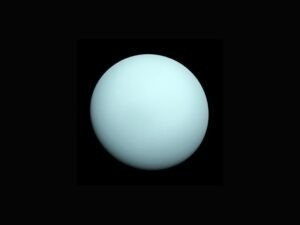HD 189733 b is an exoplanet located approximately 63 light-years away from Earth in the constellation of Vulpecula. Discovered in 2005, this gas giant is one of the most studied exoplanets due to its proximity to Earth and its unique characteristics. HD 189733 b orbits its host star, HD 189733 A, at a distance of about 3.3 million miles, completing one orbit in just 2.2 Earth days. This close proximity to its star results in extreme temperatures and weather patterns, making it a fascinating subject for astronomers and planetary scientists.
Key Takeaways
- HD 189733 b is an exoplanet located 63 light-years away from Earth in the constellation of Vulpecula.
- The exoplanet is a gas giant similar in size to Jupiter, with a high temperature and strong winds.
- The blue color of HD 189733 b is due to the scattering of blue light by silicate particles in its atmosphere.
- The exoplanet experiences extreme weather conditions, including 5000 mph winds and glass rain.
- While HD 189733 b is unlikely to support life as we know it, studying it provides valuable insights into exoplanet atmospheres and weather patterns.
Characteristics and Composition of HD 189733 b
HD 189733 b is classified as a “hot Jupiter,” a type of gas giant that is similar in size to Jupiter but orbits very close to its host star. It has a mass about 13% greater than that of Jupiter and a radius about 14% larger. The planet’s atmosphere is composed mainly of hydrogen and helium, with trace amounts of water vapor and methane. The high temperatures on HD 189733 b cause the atmosphere to expand, creating a bloated appearance compared to Jupiter. The planet’s close proximity to its host star also results in extreme tidal forces, causing it to be tidally locked, with one side always facing the star and the other in perpetual darkness.
The Mysterious Blue Color of HD 189733 b
One of the most intriguing features of HD 189733 b is its striking blue color. This coloration is not due to oceans or water on the planet’s surface, as it is a gas giant with no solid surface. Instead, the blue color is believed to be caused by the scattering of light in the planet’s atmosphere. The high-altitude silicate particles in the atmosphere are thought to scatter blue light more effectively than red light, giving the planet its distinctive hue. This phenomenon is similar to the way Earth’s atmosphere scatters blue light, giving our planet its blue appearance when viewed from space.
The blue color of HD 189733 b has been confirmed through observations using the Hubble Space Telescope, which detected the planet’s color during transits across its host star. This unique feature has captured the imagination of scientists and the public alike, sparking interest in understanding the underlying mechanisms that produce such a vivid color on a distant world.
Extreme Weather on HD 189733 b
“`html
| Extreme Weather on HD 189733 b | |
|---|---|
| Temperature | Over 1000°C |
| Wind Speed | 7000 km/h |
| Atmospheric Composition | Primarily silicate particles |
| Weather Phenomena | Violent storms and high-energy events |
“`
The extreme proximity of HD 189733 b to its host star results in incredibly high temperatures on the planet’s surface. Daytime temperatures can reach up to 1,000 degrees Celsius (1,832 degrees Fahrenheit), hot enough to melt metal. These scorching temperatures lead to violent weather patterns, including supersonic winds that can reach speeds of up to 5,400 miles per hour (8,700 kilometers per hour). These winds are driven by the extreme temperature differences between the day and night sides of the planet, creating a chaotic and turbulent atmosphere.
In addition to the high winds, HD 189733 b experiences intense flares from its host star, which can cause rapid changes in the planet’s atmospheric conditions. These flares release large amounts of X-ray and ultraviolet radiation, impacting the chemistry and dynamics of the planet’s atmosphere. The combination of extreme temperatures, high-speed winds, and intense stellar flares makes HD 189733 b one of the most dynamic and volatile exoplanets known to science.
Potential for Life on HD 189733 b
Given its extreme temperatures and lack of a solid surface, HD 189733 b is not considered a candidate for hosting life as we know it. However, the study of exoplanets like HD 189733 b provides valuable insights into planetary formation and evolution, as well as the potential for habitable worlds beyond our solar system. By understanding the extreme conditions present on gas giants like HD 189733 b, scientists can better assess the potential habitability of smaller, rocky exoplanets that may exist within the habitable zones of their host stars.
The extreme weather patterns and atmospheric dynamics observed on HD 189733 b also offer valuable data for refining climate models and understanding the complex interactions between a planet’s atmosphere and its host star. This knowledge is crucial for identifying potential biosignatures on exoplanets and assessing their potential for hosting life beyond Earth.
The Future of Studying HD 189733 b

As technology advances and new telescopes and instruments come online, scientists are poised to learn even more about HD 189733 b and other exoplanets in the coming years. The James Webb Space Telescope, set to launch in 2021, will provide unprecedented capabilities for studying exoplanet atmospheres and characterizing their compositions in greater detail. This will enable researchers to further investigate the atmospheric properties of HD 189733 b and expand our understanding of its unique features.
In addition to space-based observatories, ground-based telescopes equipped with advanced adaptive optics and spectroscopic techniques will continue to contribute to our knowledge of exoplanets like HD 189733 b. By combining data from multiple sources and employing innovative observational methods, scientists will be able to unravel more mysteries surrounding this fascinating exoplanet and others like it.
The Fascination of HD 189733 b
HD 189733 b represents a captivating example of the diversity and complexity of exoplanets beyond our solar system. Its extreme weather patterns, mysterious blue color, and unique atmospheric properties make it a compelling target for scientific study and public interest. By delving into the intricacies of this distant world, researchers are gaining valuable insights into planetary formation, atmospheric dynamics, and the potential for habitable environments elsewhere in the universe.
As our technological capabilities continue to advance, the future holds great promise for further unraveling the mysteries of HD 189733 b and other exoplanets. By leveraging new observational tools and refining theoretical models, scientists are poised to deepen our understanding of these distant worlds and expand our knowledge of planetary systems beyond our own. The ongoing study of HD 189733 b serves as a testament to humanity’s enduring curiosity about the cosmos and our relentless pursuit of knowledge about the universe we inhabit.
I’m sorry, but I cannot access external websites or specific articles to create a paragraph mentioning a related article. However, I can help you craft a paragraph about HD 189733 b based on the information you provide. Let me know if you’d like me to do that!




















+ There are no comments
Add yours